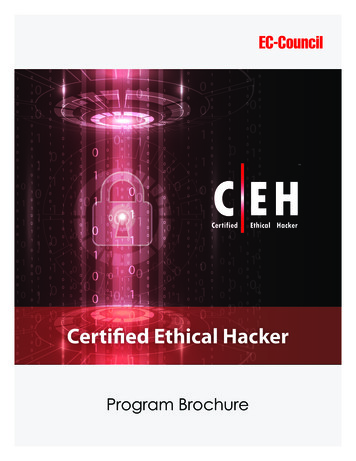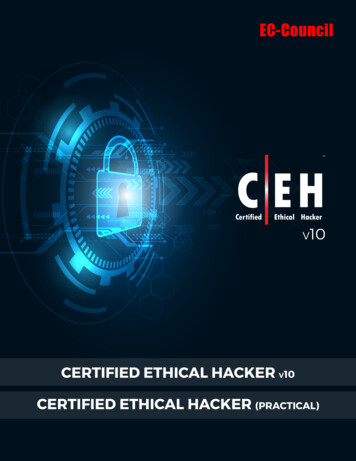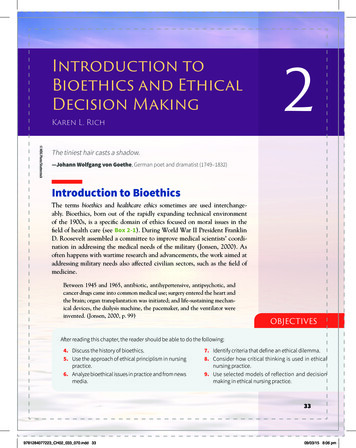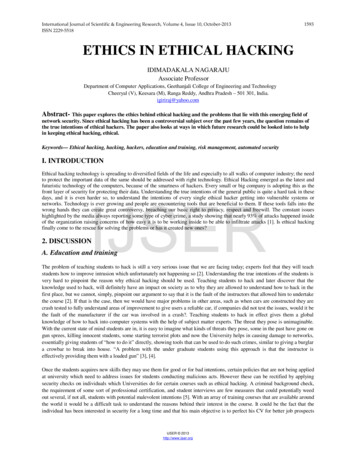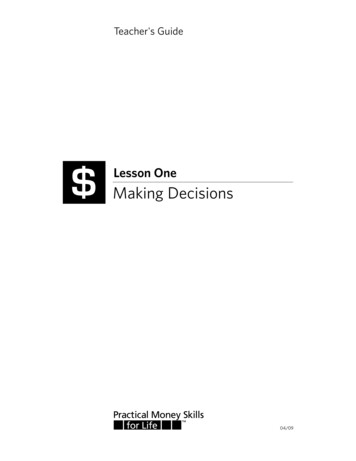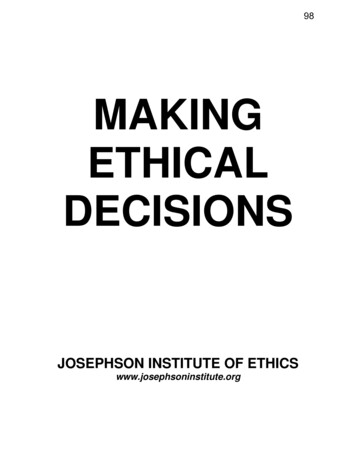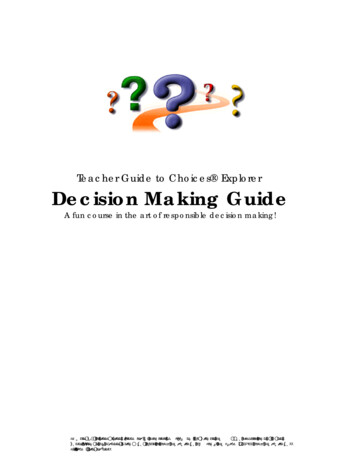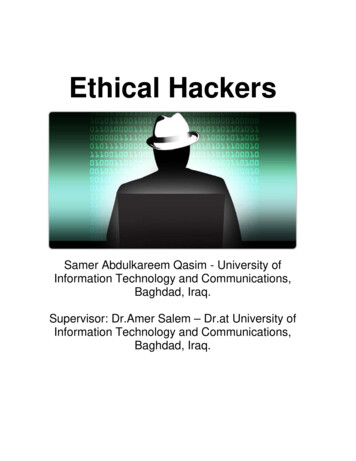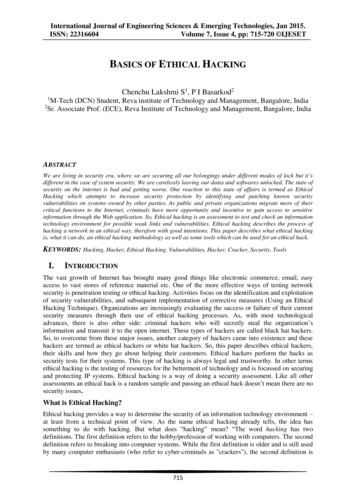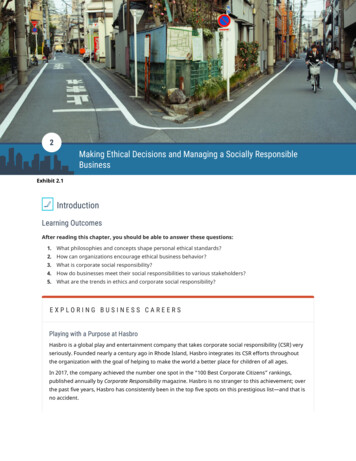
Transcription
2Making Ethical Decisions and Managing a Socially ResponsibleBusinessExhibit 2.1IntroductionLearning OutcomesAfter reading this chapter, you should be able to answer these questions:1. What philosophies and concepts shape personal ethical standards?2. How can organizations encourage ethical business behavior?3. What is corporate social responsibility?4. How do businesses meet their social responsibilities to various stakeholders?5. What are the trends in ethics and corporate social responsibility?EXPLORING BUSINESS CAREERSPlaying with a Purpose at HasbroHasbro is a global play and entertainment company that takes corporate social responsibility (CSR) veryseriously. Founded nearly a century ago in Rhode Island, Hasbro integrates its CSR efforts throughoutthe organization with the goal of helping to make the world a better place for children of all ages.In 2017, the company achieved the number one spot in the “100 Best Corporate Citizens” rankings,published annually by Corporate Responsibility magazine. Hasbro is no stranger to this achievement; overthe past five years, Hasbro has consistently been in the top five spots on this prestigious list—and that isno accident.
60Chapter 2 Making Ethical Decisions and Managing a Socially Responsible BusinessExhibit 2.2Hasbro’s Monopoly game (Credit: Ben Tsai/ Flickr/ Public Domain)With more than 5,000 employees, Hasbro relies heavily on its strategic brand blueprint to guide itsefforts in CSR, innovation, philanthropy, and product development. With a business portfolio thatincludes such well-known brands as Nerf, Play-Doh, Transformers, Monopoly, and The Game of Life, thecompany focuses its CSR efforts on four key areas: product safety, environmental sustainability, humanrights and ethical sourcing, and community.According to the company, product safety is its highest priority. Hasbro uses a five-step qualityassurance process that starts with design and then moves to engineering, manufacturing, andpackaging. Another key part of product safety at Hasbro is incorporating continuous feedback from bothconsumers and retailers and insisting that these high standards and quality processes apply to all thirdparty factories worldwide that manufacture its products.Hasbro is also committed to finding new ways to reduce its environmental footprint. Over the pastseveral years, the company has reduced energy consumption, cut greenhouse gas emissions, andreduced water consumption and waste production in its production facilities. In addition, Hasbro hastotally eliminated the use of wire ties in all of its product packaging, saving more than 34,000 miles ofwire ties—more than enough to wrap around the earth’s circumference.Human rights and ethical sourcing remains a key ingredient of Hasbro’s CSR success. Treating peoplefairly is a core company value, as is working diligently to make great strides in diversity and inclusion atall levels of the organization. Company personnel work closely with third-party factories to ensure thatthe human rights of all workers in the Hasbro global supply chain are recognized and upheld.Philanthropy, corporate giving, and employee volunteering are key components of the Hasbrocommunity. Through its various charitable programs, Hasbro made close to 15 million in financialcontributions and product donations in 2016, which reached close to an estimated 4 million childrenaround the globe. Several years ago the company started an annual Global Day of Joy as a way ofThis OpenStax book is available for free at http://cnx.org/content/col25734/1.7
Chapter 2 Making Ethical Decisions and Managing a Socially Responsible Business61engaging its employees worldwide in community service. In a recent year, more than 93 percent ofHasbro’s employees participated in service projects in more than 40 countries.Hasbro is in the business of storytelling, and its CSR efforts tell the story of an ethical, responsibleorganization whose mission is to create the world’s best play experiences. Its ability to be accountablefor its actions and to help make the world a better place one experience at time continues to make it ahighly successful company.Sources: Brian Goldner, “Who Are You Really?—Brian Goldner, President & CEO for Hasbro, Inc.,”http://insights.ethisphere.com, accessed June 29, 2017; “CSR Fact Sheet,” https://csr.hasbro.com,accessed June 23, 2017; “The World’s Biggest Public Companies: Hasbro,” Forbes,https://www.forbes.com, accessed June 23, 2017; “2016 Global Philanthropy & Social Impact,”https://csr.hasbro.com, accessed June 23, 2017; Elizabeth Gurdus, “Hasbro CEO Reveals the MagicBehind the Toymaker’s Earnings Beat,” CNBC, http://www.cnbc.com, April 24, 2017; Jade Burke, “HasbroReaches Top Spot in CSR Listing,” Toy News, http://www.toynews-online.biz, April 21, 2017; KathrinBelliveau, “CSR at Hasbro: What It Means to Play with Purpose,” LinkedIn, https://www.linkedin.com,April 20, 2017.Every day, managers and business owners make business decisions based on what they believe to be rightand wrong. Through their actions, they demonstrate to their employees what is and is not acceptable behaviorand shape the moral standard of the organization. As you will see in this module, personal and professionalethics are important cornerstones of an organization and shape its ultimate contributions to society in theform of corporate social responsibility. First, let’s consider how individual business ethics are formed.2.1Understanding Business Ethics1. What philosophies and concepts shape personal ethical standards?Ethics is a set of moral standards for judging whether something is right or wrong. The first step inunderstanding business ethics is learning to recognize an ethical issue. An ethical issue is a situation wheresomeone must choose between a set of actions that may be ethical or unethical. For example, Martin Shkreli,former CEO of Turing Pharmaceuticals, raised the price of a drug used for newborns and HIV patients by morethan 5000 percent, defending the price increase as a “great business decision.”1 Few people would call thatethical behavior. But consider the actions of the stranded, hungry people in New Orleans who lost everythingin the aftermath of Hurricane Katrina. They broke into flooded stores, taking food and bottled water withoutpaying for them. Was this unethical behavior? Or what about the small Texas plastics manufacturer thatemployed over 100 people and specialized in the Latin American market? The president was distraughtbecause he knew the firm would be bankrupt by the end of the year if it didn’t receive more contracts. Heknew that he was losing business because he refused to pay bribes. Bribes were part of the culture in hismajor markets. Closing the firm would put many people out of work. Should he start paying bribes in order tostay in business? Would this be unethical? Let’s look at the next section to obtain some guidance onrecognizing unethical situations.Recognizing Unethical Business ActivitiesResearchers from Brigham Young University tell us that all unethical business activities will fall into one of the
62Chapter 2 Making Ethical Decisions and Managing a Socially Responsible Businessfollowing categories:1. Taking things that don’t belong to you. The unauthorized use of someone else’s property or taking propertyunder false pretenses is taking something that does not belong to you. Even the smallest offense, such asusing the postage meter at your office for mailing personal letters or exaggerating your travel expenses,belongs in this category of ethical violations.2. Saying things you know are not true. Often, when trying for a promotion and advancement, fellowemployees discredit their coworkers. Falsely assigning blame or inaccurately reporting conversations islying. Although “This is the way the game is played around here” is a common justification, saying thingsthat are untrue is an ethical violation.3. Giving or allowing false impressions. The salesperson who permits a potential customer to believe thatcardboard boxes will hold the customer’s tomatoes for long-distance shipping when the salespersonknows the boxes are not strong enough has given a false impression. A car dealer who fails to disclosethat a car has been in an accident is misleading potential customers.4. Buying influence or engaging in a conflict of interest. A conflict of interest occurs when the officialresponsibilities of an employee or government official are influenced by the potential for personal gain.Suppose a company awards a construction contract to a firm owned by the father of the state attorneygeneral while the state attorney general’s office is investigating that company. If this construction awardhas the potential to shape the outcome of the investigation, a conflict of interest has occurred.5. Hiding or divulging information. Failing to disclose the results of medical studies that indicate your firm’snew drug has significant side effects is the ethical violation of hiding information that the product couldbe harmful to purchasers. Taking your firm’s product development or trade secrets to a new place ofemployment constitutes the ethical violation of divulging proprietary information.6. Taking unfair advantage. Many current consumer protection laws were passed because so manybusinesses took unfair advantage of people who were not educated or were unable to discern thenuances of complex contracts. Credit disclosure requirements, truth-in-lending provisions, and newregulations on auto leasing all resulted because businesses misled consumers who could not easily followthe jargon of long, complex agreements.7. Committing improper personal behavior. Although the ethical aspects of an employee’s right to privacy arestill debated, it has become increasingly clear that personal conduct outside the job can influenceperformance and company reputation. Thus, a company driver must abstain from substance abusebecause of safety issues. Even the traditional company holiday party and summer picnic have come underscrutiny due to the possibility that employees at and following these events might harm others throughalcohol-related accidents.8. Abusing power and mistreating individuals. Suppose a manager sexually harasses an employee or subjectsemployees to humiliating corrections or reprimands in the presence of customers. In some cases, lawsprotect employees. Many situations, however, are simply interpersonal abuse that constitutes an ethicalviolation.9. Permitting organizational abuse. Many U.S. firms with operations overseas, such as Apple, Nike, and LeviStrauss, have faced issues of organizational abuse. The unfair treatment of workers in internationaloperations appears in the form of child labor, demeaning wages, and excessive work hours. Although abusiness cannot change the culture of another country, it can perpetuate—or stop—abuse through itsoperations there.10. Violating rules. Many organizations use rules and processes to maintain internal controls or respect theauthority of managers. Although these rules may seem burdensome to employees trying to servecustomers, a violation may be considered an unethical act.This OpenStax book is available for free at http://cnx.org/content/col25734/1.7
Chapter 2 Making Ethical Decisions and Managing a Socially Responsible Business6311. Condoning unethical actions. What if you witnessed a fellow employee embezzling company funds byforging her signature on a check? Would you report the violation? A winking tolerance of others’unethical behavior is itself unethical.2After recognizing that a situation is unethical, the next question is what do you do? The action that a persontakes is partially based upon his or her ethical philosophy. The environment in which we live and work alsoplays a role in our behavior. This section describes personal philosophies and legal factors that influence thechoices we make when confronting an ethical dilemma.Justice—The Question of FairnessAnother factor influencing individual business ethics is justice, or what is fair according to prevailingstandards of society. We all expect life to be reasonably fair. You expect your exams to be fair, the grading tobe fair, and your wages to be fair, based on the type of work being done.Today we take justice to mean an equitable distribution of the burdens and rewards that society has to offer.The distributive process varies from society to society. Those in a democratic society believe in the “equal payfor equal work” doctrine, in which individuals are rewarded based on the value the free market places on theirservices. Because the market places different values on different occupations, the rewards, such as wages, arenot necessarily equal. Nevertheless, many regard the rewards as just. A politician who argued that asupermarket clerk should receive the same pay as a physician, for example, would not receive many votesfrom the American people. At the other extreme, communist theorists have argued that justice would beserved by a society in which burdens and rewards were distributed to individuals according to their abilitiesand their needs, respectively.Utilitarianism—Seeking the Best for the MajorityOne of the philosophies that may influence choices between right and wrong is utilitarianism, which focuseson the consequences of an action taken by a person or organization. The notion that people should act so asto generate the greatest good for the greatest number is derived from utilitarianism. When an action affectsthe majority adversely, it is morally wrong. One problem with this philosophy is that it is nearly impossible toaccurately determine how a decision will affect a large number of people.Another problem is that utilitarianism always involves both winners and losers. If sales are slowing and amanager decides to fire five people rather than putting everyone on a 30-hour workweek, the 20 people whokeep their full-time jobs are winners, but the other five are losers.A final criticism of utilitarianism is that some “costs,” although small relative to the potential good, are sonegative that some segments of society find them unacceptable. Reportedly, the backs of animals a year aredeliberately broken so that scientists can conduct spinal cord research that could someday lead to a cure forspinal cord injuries. To a number of people, however, the “costs” are simply too horrible for this type ofresearch to continue.Following Our Obligations and DutiesThe philosophy that says people should meet their obligations and duties when analyzing an ethical dilemmais called deontology. This means that a person will follow his or her obligations to another individual orsociety because upholding one’s duty is what is considered ethically correct. For instance, people who follow
64Chapter 2 Making Ethical Decisions and Managing a Socially Responsible Businessthis philosophy will always keep their promises to a friend and will follow the law. They will produce veryconsistent decisions, because they will be based on the individual’s set duties. Note that this theory is notnecessarily concerned with the welfare of others. Say, for example, a technician for Orkin Pest Control hasdecided that it’s his ethical duty (and is very practical) to always be on time to meetings with homeowners.Today he is running late. How is he supposed to drive? Is the technician supposed to speed, breaking his dutyto society to uphold the law, or is he supposed to arrive at the client’s home late, breaking his duty to be ontime? This scenario of conflicting obligations does not lead us to a clear ethically correct resolution, nor does itprotect the welfare of others from the technician’s decision.Individual RightsIn our society, individuals and groups have certain rights that exist under certain conditions regardless of anyexternal circumstances. These rights serve as guides when making individual ethical decisions. The termhuman rights implies that certain rights—to life, to freedom, to the pursuit of happiness—are bestowed at birthand cannot be arbitrarily taken away. Denying the rights of an individual or group is considered to beunethical and illegal in most, though not all, parts of the world. Certain rights are guaranteed by thegovernment and its laws, and these are considered legal rights. The U.S. Constitution and its amendments, aswell as state and federal statutes, define the rights of American citizens. Those rights can be disregarded onlyin extreme circumstances, such as during wartime. Legal rights include the freedom of religion, speech, andassembly; protection from improper arrest and searches and seizures; and proper access to counsel,confrontation of witnesses, and cross-examination in criminal prosecutions. Also held to be fundamental is theright to privacy in many matters. Legal rights are to be applied without regard to race, color, creed, gender, orability.CONCEPT CHECK1. How are individual business ethics formed?2. What is utilitarianism?3. How can you recognize unethical activities?2.2How Organizations Influence Ethical Conduct2. How can organizations encourage ethical business behavior?People choose between right and wrong based on their personal code of ethics. They are also influenced bythe ethical environment created by their employers. Consider the following headlines: Investment advisor Bernard Madoff sentenced to 150 years in prison for swindling clients out of morethan 65 billion. Former United Airlines CEO Jeff Smisek leaves the company after a federal investigation into whetherUnited tried to influence officials at the Port Authority of New York. Renaud Laplanche, the founder of Lending Club, loses his job because of faulty practices and conflicts ofinterest at the online peer-to-peer lender. Wells Fargo CEO John Stumpf fired after company employees opened more than 2 million fake accountsThis OpenStax book is available for free at http://cnx.org/content/col25734/1.7
Chapter 2 Making Ethical Decisions and Managing a Socially Responsible Business65to meet aggressive sales targets.3As these actual stories illustrate, poor business ethics can create a very negative image for a company, can beexpensive for the firm and/or the executives involved, and can result in bankruptcy and jail time for theoffenders. Organizations can reduce the potential for these types of liability claims by educating theiremployees about ethical standards, by leading through example, and through various informal and formalprograms.Leading by ExampleEmployees often follow the examples set by their managers. That is, leaders and managers establish patternsof behavior that determine what’s acceptable and what’s not within the organization. While Ben Cohen waspresident of Ben & Jerry’s ice cream, he followed a policy that no one could earn a salary more than seventimes that of the lowest-paid worker. He wanted all employees to feel that they were equal. At the time heresigned, company sales were 140 million, and the lowest-paid worker earned 19,000 per year. Ben Cohen’ssalary was 133,000, based on the “seven times” rule. A typical top executive of a 140 million company mighthave earned 10 times Cohen’s salary. Ben Cohen’s actions helped shape the ethical values of Ben & Jerry’s.Offering Ethics Training ProgramsIn addition to providing a system to resolve ethical dilemmas, organizations also provide formal training todevelop an awareness of questionable business activities and practice appropriate responses. Manycompanies have some type of ethics training program. The ones that are most effective, like those created byLevi Strauss, American Express, and Campbell Soup Company, begin with techniques for solving ethicaldilemmas such as those discussed earlier. Next, employees are presented with a series of situations and askedto come up with the “best” ethical solution. One of these ethical dilemmas is shown in Table 2.1. According toa recent survey by the Ethics Resource Center, more than 80 percent of U.S. companies provide some sort ofethics training for employees, which may include online activities, videos, and even games.4An Ethical Dilemma Used for Employee TrainingBill Gannon was a middle manager of a large manufacturer of lighting fixtures in Newark, NewJersey. Bill had moved up the company ladder rather quickly and seemed destined for uppermanagement in a few years. Bill’s boss, Dana Johnson, had been pressuring him about thesemiannual reviews concerning Robert Talbot, one of Bill’s employees. Dana, it seemed, would notaccept any negative comments on Robert’s evaluation forms. Bill had found out that a previousmanager who had given Robert a bad evaluation was no longer with the company. As Bill reviewedRobert’s performance for the forthcoming evaluation period, he found many areas of subparperformance. Moreover, a major client had called recently complaining that Robert had filled alarge order improperly and then had been rude to the client when she called to complain.Table 2.1
66Chapter 2 Making Ethical Decisions and Managing a Socially Responsible BusinessAn Ethical Dilemma Used for Employee TrainingDiscussion Questions1. What ethical issues does the situation raise?2. What courses of action could Bill take? Describe the ethics of each course.3. Should Bill confront Dana? Dana's boss?4. What would you do in this situation? What are the ethical implications?Table 2.1Establishing a Formal Code of EthicsMost large companies and thousands of smaller ones have created, printed, and distributed codes of ethics. Ingeneral, a code of ethics provides employees with the knowledge of what their firm expects in terms of theirresponsibilities and behavior toward fellow employees, customers, and suppliers. Some ethical codes offer alengthy and detailed set of guidelines for employees. Others are not really codes at all but rather summarystatements of goals, policies, and priorities. Some companies have their codes framed and hung on officewalls, included as a key component of employee handbooks, and/or posted on their corporate websites.Examples of company codes of ethics:Costco http://phx.corporate-ir.net/phoenix.zhtml?c 83830&p irol-govhighlightsStarbucks tion/business-ethics-and-complianceAT&T https://www.att.com/gen/investor-relations?pid 5595Do codes of ethics make employees behave in a more ethical manner? Some people believe that they do.Others think that they are little more than public relations gimmicks. If senior management abides by the codeof ethics and regularly emphasizes the code to employees, then it will likely have a positive influence onbehavior.The “100 Best Corporate Citizens” as ranked by Corporate Responsibility magazine are selected based on sevencategories, including employee relations, human rights, corporate governance (including code of ethics),philanthropy and community support, financial performance, environment, and climate change.5 The topcorporate citizens in 2017 were:1. Hasbro, Inc.2. Intel Corp.3. Microsoft Corp.4. Altria Group, Inc.5. Campbell Soup Company6. Cisco Systems, Inc.7. Accenture8. Hormel Foods Corp.9. Lockheed Martin Corp.10. Ecolab, Inc.This OpenStax book is available for free at http://cnx.org/content/col25734/1.7
Chapter 2 Making Ethical Decisions and Managing a Socially Responsible BusinessC U S T O M E R S AT I S FA C T I O N A N D Q U A L I T YCampbell’s Adds CSR to Its RecipeThe Campbell Soup Company is no longer just about traditional cans of processed soup. Under theguidance of its management team, particularly its former CEO Denise Morrison (Morrison retired fromCampbell’s in July of 2018), Campbell’s has undergone a transformation that includes a strong emphasison organics and fresh food—and a large serving of corporate citizenship.Named one of the Best Corporate Citizens by Corporate Responsibility magazine in 2017, Campbell’s isworking to make sustainability and transparency part of its business DNA, and this culture shift has hadan important influence on the company’s business strategies.Morrison, who took over as CEO in 2011, is a firm believer in the company’s central vision: real food thatmatters for life’s moments. “We can make a profit and make a difference, and we are doing boththrough our business . . . in a way that’s authentic, that’s transparent, and that truly matters,” sheexplains.Under Morrison’s watch, the company recently acquired several fresh food and organic companies,including Bolthouse Farms, one of the largest suppliers of fresh carrots in the United States, and GardenFresh Gourmet, which produces a top line of fresh salsa and hummus. Tracking the strong change inconsumer preference for healthier food, Campbell’s also recently acquired Plum Organics, a line oforganic baby food products, which should help solidify the company’s reputation for fresh ingredientswith millennials and their families.The company’s transformation from a processed food giant to a major competitor in the fresh foodbusiness has also had a positive influence on the company’s bottom line. Campbell’s shareholders haveto be pleased with the 20 percent increase in the company’s stock price over the past two years, as themarkets, competitors, and consumers take notice of the company’s strong commitment to sustainability.Inherent in the company’s reinvention is the strong emphasis on corporate citizenship—doing good andgiving back seem to be top priorities for Campbell’s. In addition to acquiring sustainable and fresh foodcompanies, Campbell’s has also made a conscious decision to support the communities where theiremployees live and work. For example, the company launched a healthy communities initiative inCamden, New Jersey, where Campbell’s is headquartered—an urban city that has seen its share ofeconomic and social challenges in the past. In partnership with several local organizations, this initiativehas helped fund community gardens, food pantries, nutrition education, and cooking classes that helpbuild healthy communities. The Camden experience has been so successful that the company hasexpanded the program to other cities where it operates, including Detroit, Michigan, and Norwalk,Connecticut.The company’s ongoing commitment to fresh food, community involvement, and corporate socialresponsibility has helped change the narrative when it comes to being a sustainable and ethicalorganization.Questions for Discussion1. How does Campbell Soup Company’s recent business acquisitions help support its CSR strategies?2. Provide examples of how the company’s transformation from a processed food giant to a purveyorof fresh ingredients can help attract a new group of customers.67
68Chapter 2 Making Ethical Decisions and Managing a Socially Responsible BusinessSources: “Corporate Responsibility and Sustainability Are Good for Business,”https://www.campbellsoupcompany.com, accessed June 27, 2017; “Campbell Soup Wants to Make You aPersonal Eating Plan (video),” Fortune, http://fortune.com, May 2, 2017; Don Seiffert, “Campbell SoupCEO Makes 3 Predictions about the Future of Food,” Boston Business Journal, http://www.bizjournals.com,April 13, 2017; Aaron Hurst, “How Denise Morrison Took Processed Food Icon Campbell’s on a Fresh FoodBuying Spree,” Fast Company, https://www.fastcompany.com, March 2, 2017; Abigail Stevenson,“Campbell Soup CEO: Stunning Disruption in the Ecosystem of Food,” CNBC, http://www.cnbc.com, July21, 2016.Making the Right DecisionIn many situations, there may be no simple right or wrong answers. Yet there are several questions you canask yourself, and a couple of self-tests you can do, to help you make the right ethical decision. First, askyourself, “Are there any legal restrictions or violations that will result from the action?” If so, take a differentcourse of action. If not, ask yourself, “Does it violate my company’s code of ethics?” If so, again find a differentpath to follow. Third, ask, “Does this meet the guidelines of my own ethical philosophy?” If the answer is “yes,”then your decision must still pass two important tests.The Feelings TestYou must now ask, “How does it make me feel?” This enables you to examine your comfort level with aparticular decision. Many people find that, after reaching a decision on an issue, they still experiencediscomfort that may manifest itself in a loss of sleep or appetite. Those feelings of conscience can serve as afuture guide in resolving ethical dilemmas.The Newspaper or Social Media TestThe final test involves the front page of the newspaper or social media posts. The question to be asked is howan objective reporter would describe your decision in a front-page newspaper story, an online media site, or asocial media platform such as Twitter or Facebook. Some managers rephrase the test for their employees:How will the headline read if I make this decision, or what will be the reaction of my social media followers?This test is helpful in spotting and resolving potential conflicts of interest.This OpenStax book is available for free at http://cnx.org/content/col25734/1.7
Chapter 2 Making Ethical Decisions and Managing a Socially Responsible BusinessExhibit 2.369Making an ethical decision might come down to how you feel about the decision or to the newspaper or social media post test.The question to ask yourself is how the decision would make you feel if an objective reporter described the decision on the front page of anewspaper or via a social media post on Twitter or Facebook—all of which would be viewed by many, many people. Speaking of social media, itplays a pivotal role in ethical decision-making today, when people use the medium to share critical comments about friends as well asemployers, business colleagues, and competitors. Should companies view employees’ social media pages on a regular basis, or is that informationoff-limits to employers? (Credit: Mike MacKenzie/ Flickr/ Attribution 2.0 Generic (CC BY 2.0))C
First, let’s consider how individual business ethics are formed. 2.1 Understanding Business Ethics 1. What philosophies and concepts shape personal ethical standards? Ethics is a set of moral standards for judging whether something is right or wrong. The first step in understanding business ethics
